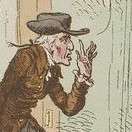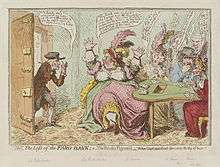George Hobart, 3rd Earl of Buckinghamshire
George Hobart, 3rd Earl of Buckinghamshire (8 September 1731 – 14 November 1804) was a British peer, styled The Honourable George Hobart from 1733 until 1793.[1]

Life
Hobart was the son of John Hobart, 1st Earl of Buckinghamshire by his second wife, Elizabeth Bristow. He was educated at Westminster School.

Hobart represented the constituencies of St Ives and Bere Alston in the House of Commons from 1754 to 1761 and 1761 to 1780, respectively. He was secretary to the embassy in St Petersburg in 1762, his half-brother John Hobart, 2nd Earl of Buckinghamshire being then ambassador.[1]
He inherited the earldom of Buckinghamshire from his half-brother, who had no surviving sons, in 1793. On 29 April 1797, he was commissioned colonel of the 3rd Regiment of Lincolnshire Militia (South Lincolnshire Supplementary Militia), becoming a colonel in the regular army when his regiment was embodied on 12 January 1799.[1] He died in 1804 and was succeeded by his son Robert, who had already entered the House of Lords in 1798 by a writ of acceleration as Baron Hobart.
Family
Hobart married Albinia Bertie, second daughter of Lord Vere Bertie and the heiress Ann Casey, on 16 May 1757.[3] They had eight children:
- Robert Hobart, 4th Earl of Buckinghamshire (1760–1816)
- Hon. George Vere Hobart (1761 – 5 December 1802), married first Jane Cataneo and had issue, married second, in April 1802, Janet Maclean and had issue
- Lt. the Hon. Charles Hobart, RN (died April 1782)
- Rev. the Hon. Henry Lewis Hobart (1774 – 8 May 1846), married Charlotte Selina Moore and had issue
- Lady Albinia Hobart, married Richard Cumberland on the 14th Jul 1784 and had issue
- Lady Henrietta Anne Barbara Hobart (c. 1762 – 1828), married, in 1789, John Sullivan and had issue
- Lady Maria Frances Hobart (c. 1762 – 1794), married George North, 3rd Earl of Guilford and had issue
- Lady Charlotte Hobart (died 1798), married Col. Edward Disbrowe (died 1818) and had issue, including Edward Cromwell Disbrowe.
References
- Doyle, James William Edmund (1886). The Official Baronage of England, v. 1. London: Longmans, Green. p. 273.
- Thomas Wright; Robert Harding Evans (1851). Historical and Descriptive Account of the Caricatures of James Gillray: Comprising a Political and Humorous History of the Latter Part of the Reign of George the Third. Bohn. pp. 426–7. Retrieved 30 March 2013.
- Matthew Kilburn, ‘Hobart, George, third earl of Buckinghamshire (1731–1804)’, Oxford Dictionary of National Biography, Oxford University Press, 2004; online edn, Jan 2008 accessed 4 June 2017
- Lee, Sidney, ed. (1891). . Dictionary of National Biography. 27. London: Smith, Elder & Co.
External links
- Hansard 1803–2005: contributions in Parliament by the Earl of Buckinghamshire
| Parliament of Great Britain | ||
|---|---|---|
| Preceded by John Bristow Samuel Stephens |
Member of Parliament for St Ives 1754–1761 With: James Whitshed |
Succeeded by Humphrey Mackworth Praed Charles Hotham |
| Preceded by Sir Francis Drake John Bristow |
Member of Parliament for Bere Alston 1761–1780 With: Sir Francis Drake 1761–1771 Francis William Drake 1771–1774 Sir Francis Drake 1774–1780 |
Succeeded by The Lord Macartney Lord Algernon Percy |
| Peerage of Great Britain | ||
| Preceded by John Hobart |
Earl of Buckinghamshire 1793–1804 |
Succeeded by Robert Hobart |
| Baron Hobart (descended by acceleration) 1793–1798 | ||